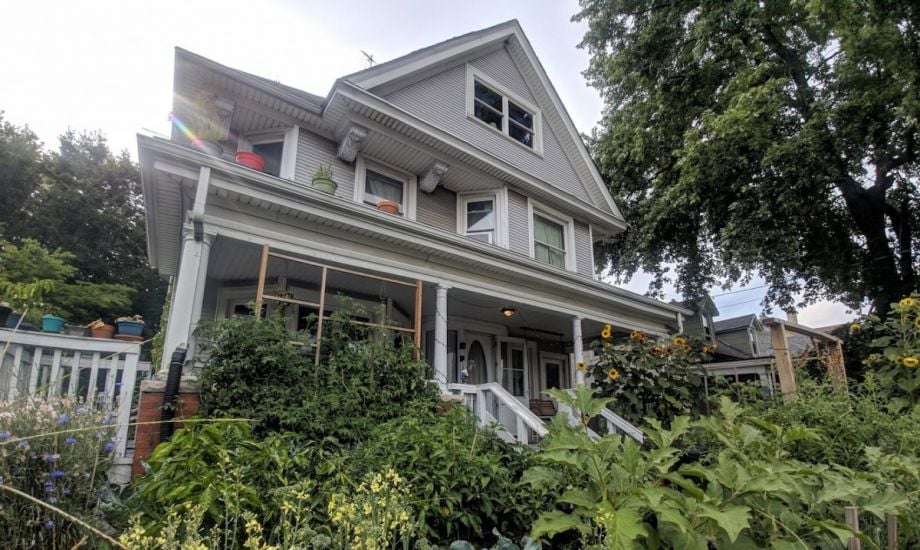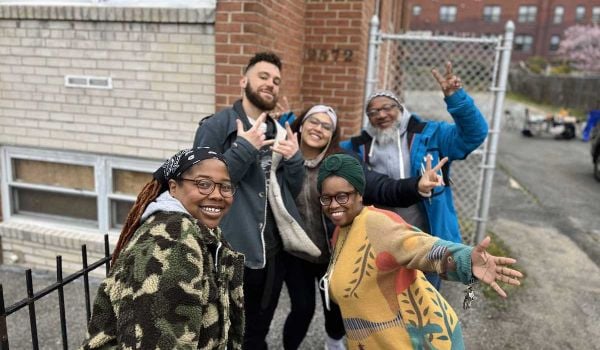When Peter Meyer Reimer moved to Chicago five years ago for a data analyst job, they knew they didn’t want to live alone. So they began researching housing cooperatives in the city, where residents share food and resources, split up chores and make decisions democratically.
They eventually applied to a group of houses called Qumbya Housing Collective, which has run co-op houses in the city since 1990, and was accepted. Reimer has lived in two different Qumbya houses, most recently spending three years in a house called Bowers, where they say they have 22 housemates sharing 18 bedrooms.
The rent is cheap — they pay $675 a month, which they split with a partner — far lower than the $1,895 average rent for a one-bedroom in Chicago. They also pay $225 a month that goes to utilities and bulk purchase of the houses’s food. But they say the main reason they moved there was for companionship. “Living alone sucks,” says 29-year-old Reimer. “I tend to think that the things that make me happy are relationships with people and friends and having people around.”
Qumbya’s houses are owned by a larger collective of cooperatively owned houses called NASCO Properties, an arm of North American Students of Cooperation (NASCO). While NASCO has its origins in the student cooperative housing movement, most of the houses in its portfolio now rent to people regardless of student status, the group says.
Student housing co-operatives have a long tradition tracing back to the early 20th century as collectively-run spaces where college students could split costs and experiment with democratic control. But the same things that make the co-op model — with its focus on shared resources and a sense of community — popular with students have made them popular with non-students, including families and single adults of all ages.
Many student housing cooperatives also have units that rent affordably, sometimes more affordably than in government-subsidized affordable housing.
NASCO Properties refers to itself as a “co-op of co-ops,” pooling equity from the buildings it owns, all of which are co-ops, to purchase more properties, fund repairs and keep rents low. It currently owns 20 buildings, including four added to its portfolio in Illinois this summer. Among these new properties is Haymarket House, part of Qumbya. (This house was previously part of NASCO Properties but was taken out of its ownership to help Qumbya qualify for a mortgage, the organization says. It’s since returned under NASCO’s umbrella after the years-long venture did not work out.)
The other newly acquired properties are Randolph House, part of Community of Urbana-Champaign Cooperative Housing (COUCH), as well as Doveland Co-op and Hoyne House, both part of Stone Soup Cooperative.
“We are seeing this news as a big win for keeping these properties in Chicago out of the speculative housing market,” says NASCO director of community engagement Bronwyn Walls.
Daniel Miller, NASCO’s director of properties, says that after the turmoil of the pandemic, some co-ops like Stone Soup found themselves reevaluating their model and how independent they wanted to be. “The Stone Soup Co-ops were saying, we would like to keep the parts of the member-run, volunteer-run co-op that matter to us, and we would also like the outside support of an organization that leaves those things to us,” Miller says.
NASCO began in 1968 when a group of student housing organizers were looking to promote cooperative student housing nationally. As a result of the group’s lobbying, student co-ops were able to directly receive federal loans meant for college housing for the first time. In the 1980s, the organization founded NASCO Properties when a large Austin-based student housing co-op was about to lose some of its buildings. Another student housing group in Ann Arbor came through with a loan, which allowed NASCO to purchase the properties and lease them back to the group in Austin. NASCO Properties then grew into a tool to acquire and preserve co-operative housing at a larger scale.
While NASCO was initially focused on co-op student housing, many of the co-ops that work with the nonprofit have expanded membership criteria in past decades, taking in older residents and families. Most of the properties operated by NASCO Properties are now not exclusively student housing, the nonprofit says.
“The business model that had its roots in these student housing co-ops turns out to work for a lot of people,” Miller says. He says more co-ops looked around and realized that more people could “take advantage of the work we’re doing and the mission that we have.”
Typically, NASCO Properties acquires a building, then leases it back to a co-op and provides property management support, which can include workshops or administrative help. The rent is determined by a board at NASCO — composed of members of each co-op — and is based on the mortgage and other costs for each building. Any rent increase above the rate of inflation has to be approved by the board, Miller says. Each house then determines how to divide up that rent among its members. The organization’s bylaws do not permit it to make a profit from any of the buildings. Miller says that the per-person lease payments for each building are generally around 50% to 70% of market rate.
The model can be a boon to smaller co-ops that run into financial problems, as co-op leaders say many have during the Covid-19 pandemic. “These small grassroots groups who are organizing self-managed housing are able to scale because they can pool resources,” says Bronwyn Walls.
The student cooperative housing model is less familiar to most people than other models of affordable housing, like limited equity co-ops. In that form of housing, individual apartment owners in a multifamily building share a portion of the building’s value and decide, collectively, on a maximum resale value that will keep the units affordable to future buyers.
In NASCO’s model, the equity from all the buildings remains within the organization. The value that’s gained from the property over time is devoted to the organization’s goals of purchasing or subsidizing more co-ops. Walls says that most people’s lack of familiarity with the model can make it difficult for the nonprofit to apply for outside funding or support.
Miller says that the shift to non-student renters also occurred because of an increase in part-time college attendance. According to Department of Education data, as of Fall 2020, 73% of students at four-year degree colleges (about 8 million) were attending school full-time, with the remaining 27% (2.9 million) attending part-time. “Maybe 30 years ago, the line between college student and not college student was a very sharp line, and (now) it’s a much blurrier line,” he says.
When Reimer tells people that they live with more than 20 housemates, most seem to think that Reimer lives in a “crust-punk squat.” In fact, says Reimer, who represents their building on the NASCO Properties board, “this is one of the cleanest places I’ve lived.”
Reimer’s co-op building, Bowers, is an 18-bedroom mansion-turned-boarding house-turned-co-op near the University of Chicago with 23 residents. Each room rents for between $500-$800 a month, they say.
There are a few couples who share a room, including Reimer and their partner, as well as two friends rooming together to save money on rent. The house members eat a meal together every day, and a different member cooks for the entire house each day. Because there’s 23 people living in the house, “you end up cooking about once every three weeks or so for everyone,” Reimer says. Another two people who don’t sleep in the home are “boarders,” meaning they pay into the shared meals and show up to eat. They’re also friends with other housemates and spend a lot of time in the house, Reimer says.
Adult residents of the house are between the ages of 23 and 55 and one couple have a 4-year-old and a 13-year-old who live in the house. Reimer says that in the past, there have been adult house members who were as young as 19 and someone in their late 70s. The amount of time people live in the co-op varies; one housemate has been there for 12 years. Reimer says that at one point about two-thirds of residents at Bowers were students, but now only one fifth are students, mostly in graduate school.
When space frees up, prospective housemates apply to the new room and are interviewed by co-op members. Reimer, who has sat in on many applicant interviews, says the co-op usually interviews 10-15 people for each opening. The number of applicants dipped early on in the pandemic, they say, when people understandably didn’t want to live in close quarters with other people for fear of transmission.
Reimer says people have myriad reasons for wanting to join the co-op.
“We do get a lot of applications from people who have recently ended long-term relationships and who are looking for some community in their life, but we also get a lot of applications from couples who are feeling isolated living on their own without other community nearby,” they say.
While people enter and exit the co-ops at all different ages and life stages, the decision to rent, share meals and live collaboratively with large groups of people — most of whom are strangers at time of move-in — is a lifestyle choice that’s not for everyone. But for some seeking to escape isolation, it’s ideal.
Reimer, for one, plans to live in co-ops for the long haul. “That we get to decide what to do with it together is really empowering,” they say. “That kind of direct democracy is something I want to see in workplaces. I want to see it in housing, I want to see it in as many parts of the economy as we can put it into.”
This story was co-published in collaboration with Shelterforce, the only independent, non-academic publication covering the worlds of affordable housing, community development and housing justice. The piece has been updated to reflect that Doveland is part of the Stone Soup co-op, not Qumbya, and to correct a source’s pronouns.
This article is part of Backyard, a newsletter exploring scalable solutions to make housing fairer, more affordable and more environmentally sustainable. Subscribe to our weekly Backyard newsletter.

Roshan Abraham is Next City's housing correspondent and a former Equitable Cities fellow. He is based in Queens. Follow him on Twitter at @roshantone.


















